2007 GMC SIERRA CLASSIC lock
[x] Cancel search: lockPage 355 of 674
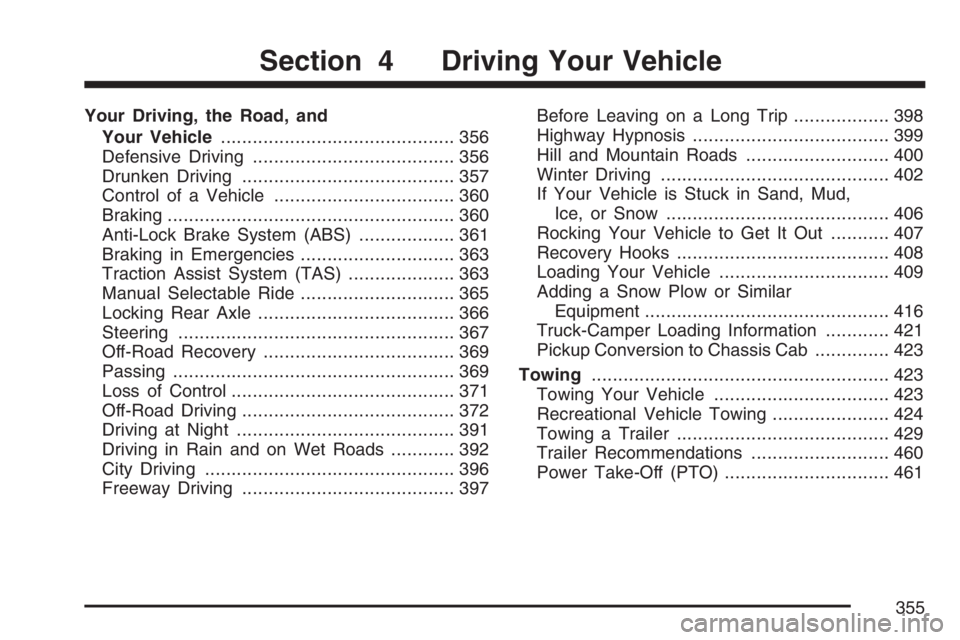
Your Driving, the Road, and
Your Vehicle............................................ 356
Defensive Driving...................................... 356
Drunken Driving........................................ 357
Control of a Vehicle.................................. 360
Braking...................................................... 360
Anti-Lock Brake System (ABS).................. 361
Braking in Emergencies............................. 363
Traction Assist System (TAS).................... 363
Manual Selectable Ride............................. 365
Locking Rear Axle..................................... 366
Steering.................................................... 367
Off-Road Recovery.................................... 369
Passing..................................................... 369
Loss of Control.......................................... 371
Off-Road Driving........................................ 372
Driving at Night......................................... 391
Driving in Rain and on Wet Roads............ 392
City Driving............................................... 396
Freeway Driving........................................ 397Before Leaving on a Long Trip.................. 398
Highway Hypnosis..................................... 399
Hill and Mountain Roads........................... 400
Winter Driving........................................... 402
If Your Vehicle is Stuck in Sand, Mud,
Ice, or Snow.......................................... 406
Rocking Your Vehicle to Get It Out........... 407
Recovery Hooks........................................ 408
Loading Your Vehicle................................ 409
Adding a Snow Plow or Similar
Equipment.............................................. 416
Truck-Camper Loading Information............ 421
Pickup Conversion to Chassis Cab.............. 423
Towing........................................................ 423
Towing Your Vehicle ................................. 423
Recreational Vehicle Towing...................... 424
Towing a Trailer........................................ 429
Trailer Recommendations.......................... 460
Power Take-Off (PTO)............................... 461
Section 4 Driving Your Vehicle
355
Page 361 of 674
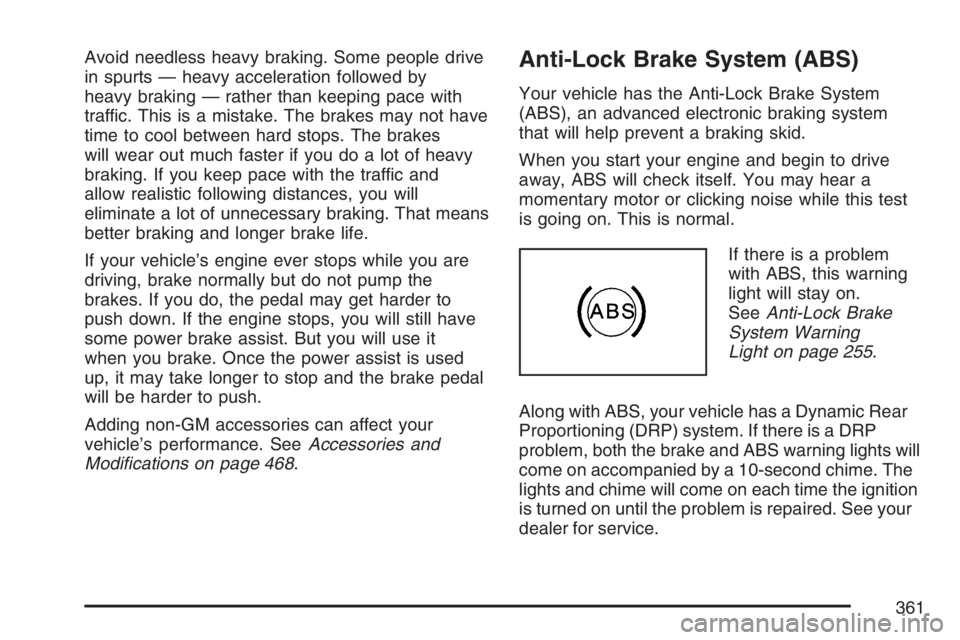
Avoid needless heavy braking. Some people drive
in spurts — heavy acceleration followed by
heavy braking — rather than keeping pace with
traffic. This is a mistake. The brakes may not have
time to cool between hard stops. The brakes
will wear out much faster if you do a lot of heavy
braking. If you keep pace with the traffic and
allow realistic following distances, you will
eliminate a lot of unnecessary braking. That means
better braking and longer brake life.
If your vehicle’s engine ever stops while you are
driving, brake normally but do not pump the
brakes. If you do, the pedal may get harder to
push down. If the engine stops, you will still have
some power brake assist. But you will use it
when you brake. Once the power assist is used
up, it may take longer to stop and the brake pedal
will be harder to push.
Adding non-GM accessories can affect your
vehicle’s performance. SeeAccessories and
Modi�cations on page 468.Anti-Lock Brake System (ABS)
Your vehicle has the Anti-Lock Brake System
(ABS), an advanced electronic braking system
that will help prevent a braking skid.
When you start your engine and begin to drive
away, ABS will check itself. You may hear a
momentary motor or clicking noise while this test
is going on. This is normal.
If there is a problem
with ABS, this warning
light will stay on.
SeeAnti-Lock Brake
System Warning
Light on page 255.
Along with ABS, your vehicle has a Dynamic Rear
Proportioning (DRP) system. If there is a DRP
problem, both the brake and ABS warning lights will
come on accompanied by a 10-second chime. The
lights and chime will come on each time the ignition
is turned on until the problem is repaired. See your
dealer for service.
361
Page 363 of 674
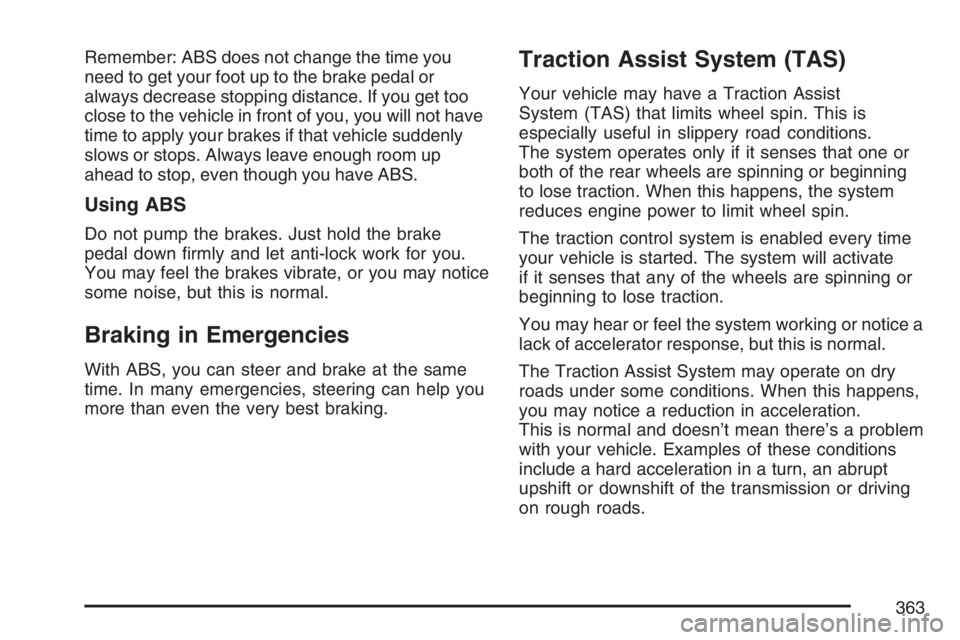
Remember: ABS does not change the time you
need to get your foot up to the brake pedal or
always decrease stopping distance. If you get too
close to the vehicle in front of you, you will not have
time to apply your brakes if that vehicle suddenly
slows or stops. Always leave enough room up
ahead to stop, even though you have ABS.
Using ABS
Do not pump the brakes. Just hold the brake
pedal down �rmly and let anti-lock work for you.
You may feel the brakes vibrate, or you may notice
some noise, but this is normal.
Braking in Emergencies
With ABS, you can steer and brake at the same
time. In many emergencies, steering can help you
more than even the very best braking.
Traction Assist System (TAS)
Your vehicle may have a Traction Assist
System (TAS) that limits wheel spin. This is
especially useful in slippery road conditions.
The system operates only if it senses that one or
both of the rear wheels are spinning or beginning
to lose traction. When this happens, the system
reduces engine power to limit wheel spin.
The traction control system is enabled every time
your vehicle is started. The system will activate
if it senses that any of the wheels are spinning or
beginning to lose traction.
You may hear or feel the system working or notice a
lack of accelerator response, but this is normal.
The Traction Assist System may operate on dry
roads under some conditions. When this happens,
you may notice a reduction in acceleration.
This is normal and doesn’t mean there’s a problem
with your vehicle. Examples of these conditions
include a hard acceleration in a turn, an abrupt
upshift or downshift of the transmission or driving
on rough roads.
363
Page 364 of 674
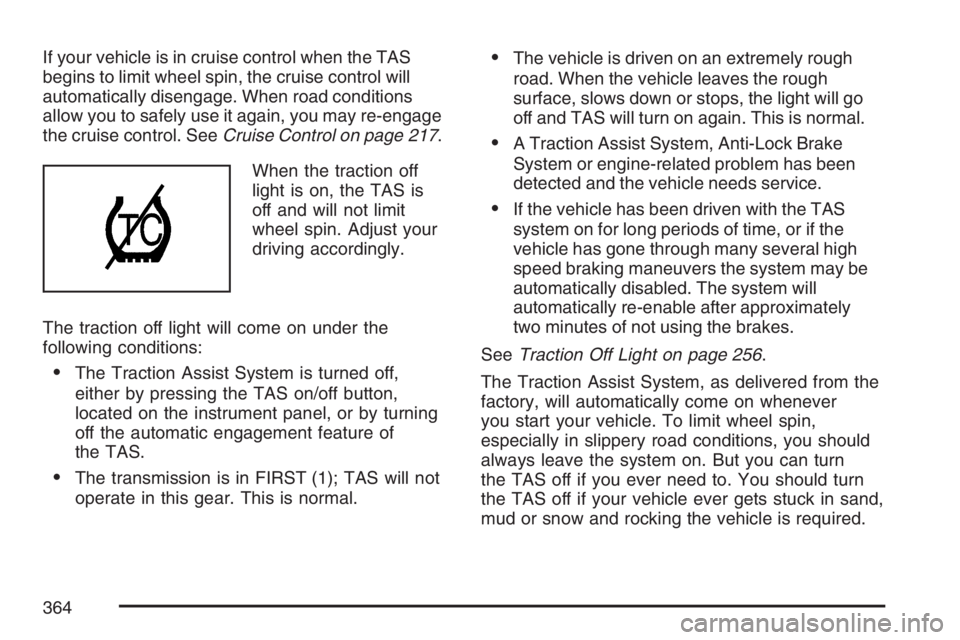
If your vehicle is in cruise control when the TAS
begins to limit wheel spin, the cruise control will
automatically disengage. When road conditions
allow you to safely use it again, you may re-engage
the cruise control. SeeCruise Control on page 217.
When the traction off
light is on, the TAS is
off and will not limit
wheel spin. Adjust your
driving accordingly.
The traction off light will come on under the
following conditions:
The Traction Assist System is turned off,
either by pressing the TAS on/off button,
located on the instrument panel, or by turning
off the automatic engagement feature of
the TAS.
The transmission is in FIRST (1); TAS will not
operate in this gear. This is normal.
The vehicle is driven on an extremely rough
road. When the vehicle leaves the rough
surface, slows down or stops, the light will go
off and TAS will turn on again. This is normal.
A Traction Assist System, Anti-Lock Brake
System or engine-related problem has been
detected and the vehicle needs service.
If the vehicle has been driven with the TAS
system on for long periods of time, or if the
vehicle has gone through many several high
speed braking maneuvers the system may be
automatically disabled. The system will
automatically re-enable after approximately
two minutes of not using the brakes.
SeeTraction Off Light on page 256.
The Traction Assist System, as delivered from the
factory, will automatically come on whenever
you start your vehicle. To limit wheel spin,
especially in slippery road conditions, you should
always leave the system on. But you can turn
the TAS off if you ever need to. You should turn
the TAS off if your vehicle ever gets stuck in sand,
mud or snow and rocking the vehicle is required.
364
Page 366 of 674

It is recommended to use this system as follows:
For superior ride comfort in an unloaded vehicle
the button should be out. The indicator light will
not be lit. This button position indicates
NORMAL levels of ride control or damping.
For superior ride comfort when trailering, fully
loaded, driving off-road, or when personal
preferences demand more control, the button
should be pressed in with the indicator light lit.
This switch position indicates FIRM levels of
ride control or damping.
The following guide can also be used to help
determine the best setting.
NORMAL:The indicator light will not be lit when
the system is in this setting. Use for normal
city and highway driving. This setting provides a
smooth, soft ride when the vehicle is unloaded.
FIRM (Unloaded):Press the button to activate
this setting, the indicator light will be lit. Use
this setting when road conditions or personal
preference demand more control. This setting
provides more “feel” or response to the road
conditions.FIRM (Loaded):Press the button to activate
this setting, the indicator light will be lit. Use this
setting to minimize trailer inputs to the vehicle
or when the vehicle is fully loaded. This setting is
also appropriate for off-road driving.
You can select a setting at any time based on
road and trailering conditions to provide the best
ride and handling. Select a new setting whenever
driving conditions change.
Locking Rear Axle
If your vehicle has this feature, your locking rear
axle can give you additional traction on snow, mud,
ice, sand or gravel. It works like a standard axle
most of the time, but when one of the rear wheels
has no traction and the other does, this feature
will allow the wheel with traction to move the
vehicle.
366
Page 368 of 674
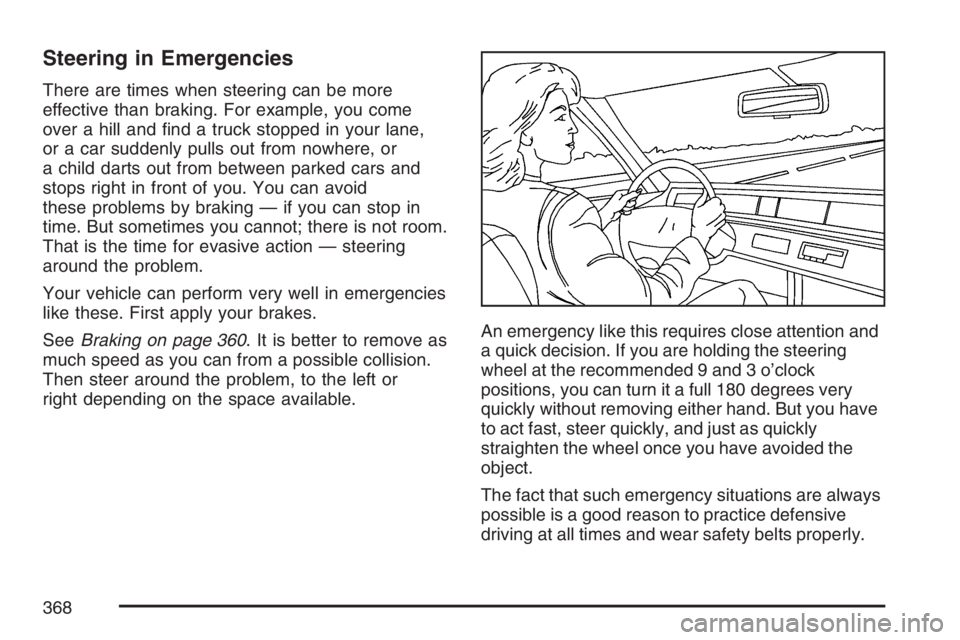
Steering in Emergencies
There are times when steering can be more
effective than braking. For example, you come
over a hill and �nd a truck stopped in your lane,
or a car suddenly pulls out from nowhere, or
a child darts out from between parked cars and
stops right in front of you. You can avoid
these problems by braking — if you can stop in
time. But sometimes you cannot; there is not room.
That is the time for evasive action — steering
around the problem.
Your vehicle can perform very well in emergencies
like these. First apply your brakes.
SeeBraking on page 360. It is better to remove as
much speed as you can from a possible collision.
Then steer around the problem, to the left or
right depending on the space available.An emergency like this requires close attention and
a quick decision. If you are holding the steering
wheel at the recommended 9 and 3 o’clock
positions, you can turn it a full 180 degrees very
quickly without removing either hand. But you have
to act fast, steer quickly, and just as quickly
straighten the wheel once you have avoided the
object.
The fact that such emergency situations are always
possible is a good reason to practice defensive
driving at all times and wear safety belts properly.
368
Page 372 of 674
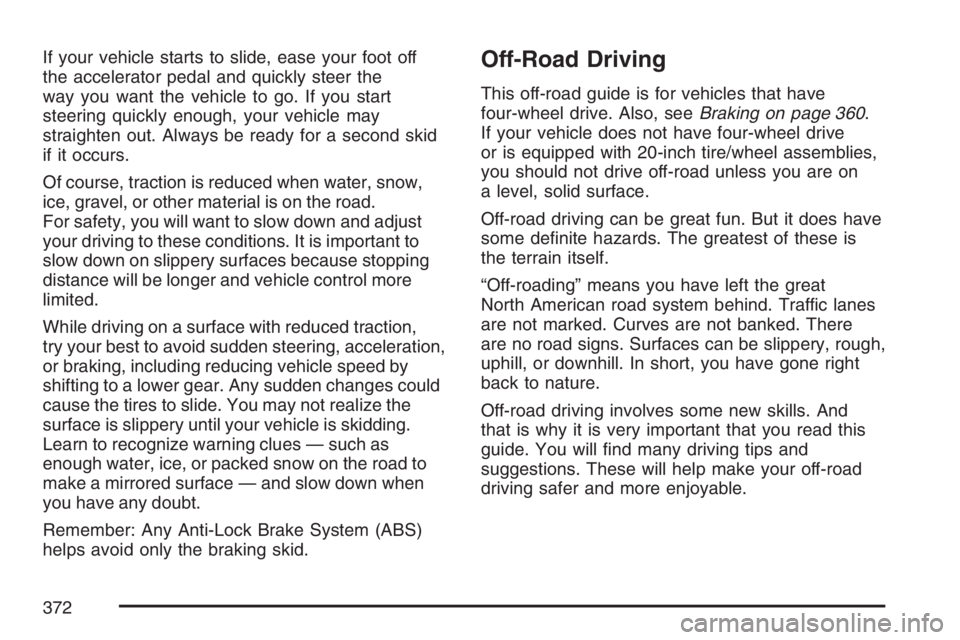
If your vehicle starts to slide, ease your foot off
the accelerator pedal and quickly steer the
way you want the vehicle to go. If you start
steering quickly enough, your vehicle may
straighten out. Always be ready for a second skid
if it occurs.
Of course, traction is reduced when water, snow,
ice, gravel, or other material is on the road.
For safety, you will want to slow down and adjust
your driving to these conditions. It is important to
slow down on slippery surfaces because stopping
distance will be longer and vehicle control more
limited.
While driving on a surface with reduced traction,
try your best to avoid sudden steering, acceleration,
or braking, including reducing vehicle speed by
shifting to a lower gear. Any sudden changes could
cause the tires to slide. You may not realize the
surface is slippery until your vehicle is skidding.
Learn to recognize warning clues — such as
enough water, ice, or packed snow on the road to
make a mirrored surface — and slow down when
you have any doubt.
Remember: Any Anti-Lock Brake System (ABS)
helps avoid only the braking skid.Off-Road Driving
This off-road guide is for vehicles that have
four-wheel drive. Also, seeBraking on page 360.
If your vehicle does not have four-wheel drive
or is equipped with 20-inch tire/wheel assemblies,
you should not drive off-road unless you are on
a level, solid surface.
Off-road driving can be great fun. But it does have
some de�nite hazards. The greatest of these is
the terrain itself.
“Off-roading” means you have left the great
North American road system behind. Traffic lanes
are not marked. Curves are not banked. There
are no road signs. Surfaces can be slippery, rough,
uphill, or downhill. In short, you have gone right
back to nature.
Off-road driving involves some new skills. And
that is why it is very important that you read this
guide. You will �nd many driving tips and
suggestions. These will help make your off-road
driving safer and more enjoyable.
372
Page 375 of 674

To reinstall the lower air dam, do the following:
1. Line up each
push-pin with its
intended retainer
and push the washer
portion of the
push-pin toward the
retainer until it
locks into place.
2. Push the �at end of
the push-pin toward
the retainer until
it locks into place,
making sure each
is secure.Before You Go Off-Roading
There are some things to do before you go out.
For example, be sure to have all necessary
maintenance and service work done. Check to
make sure all underbody shields, if the vehicle has
them, are properly attached. Be sure you read
all the information about your four-wheel-drive
vehicle in this manual. Is there enough fuel? Is the
spare tire fully in�ated? Are the �uid levels up
where they should be? What are the local
laws that apply to off-roading where you will be
driving? If you do not know, you should check with
law enforcement people in the area. Will you be
on someone’s private land? If so, be sure to
get the necessary permission.
375